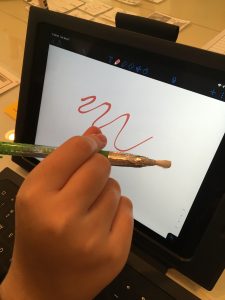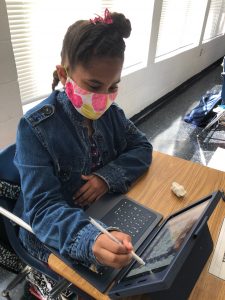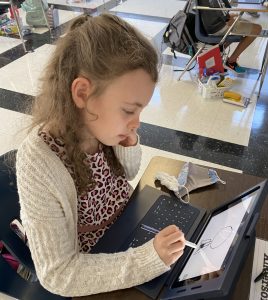
Writing and drawing on an iPad is much easier when you have a stylus or Apple Pencil. The tools can be expensive, though, ranging in price from $10 to more than $100. STEAM is a major part of the daily curriculum at Carlisle School, so rather than spending money on a manufactured, store-bought version, Mrs. Thompson’s fifth-grade students used engineering skills and basic science principles to construct their own stylus pens.
STEAM Coordinator Sherry Moschler said, “I like for students to know that they can do anything if they put their minds to it. Teaching them how to be resourceful and build things like this stylus shows students that just because something may be expensive, does not mean that it is out of their reach.”
The project calls for inexpensive materials found in almost any home. Materials used to build the stylus include the casing of a ballpoint pen, a pipe cleaner, a cotton swab, and aluminum foil. Additionally, a pair of scissors and a small amount of water is needed to complete the project.

Here is how you can make your own stylus at home:
Remove the ink tube from the inside of the ballpoint pen, leaving just the outer casing.
Take a pipe cleaner, fold it slightly shorter than the pen’s length, and then stick it inside the pen tube.
Cut off the end of the cotton swab about 2 cm long and place that into the front tip of the pen.
Cut a 6 cm square of aluminum foil. Fold it in half and cut several short slits across one of the sides.
Wrap the foil around the end of the pen (slitted side toward the cotton swab). Make sure the foil covers some of the cotton swab but not all of it. If the aluminum foil does not stay put, add a piece of scotch tape around the bottom to keep it in place.
Once the stylus is constructed, add a small drop of water to the end of the cotton swab to make it conductive and add more water as needed to re-energize it during use.
For the stylus to work properly, the cotton swab must be lightly damp, the foil must touch the cotton swab, and the skin on your hand must be touching the foil.

Reece Haymore of Danville said “It was really cool to learn how electricity (from your body) goes through the aluminum foil and water to make this work.” His tip for success is to “make sure that your aluminum foil is really tight” so that a good connection is made.
The students were excited about this project and eager to use them during class.
Grace Anderson of Danville said “It is important to learn how to make things and use engineering skills because so many jobs require knowledge of engineering to be successful.”
The homemade stylus was more sustainable than store-bought versions, according to David Good of Martinsville.
“It will save lots of money over time and will last you much longer than other devices would. You can have one pen that will last for a long time and only have to change out Q-tips (the cotton swab) every once in a while, as needed,” he said.



